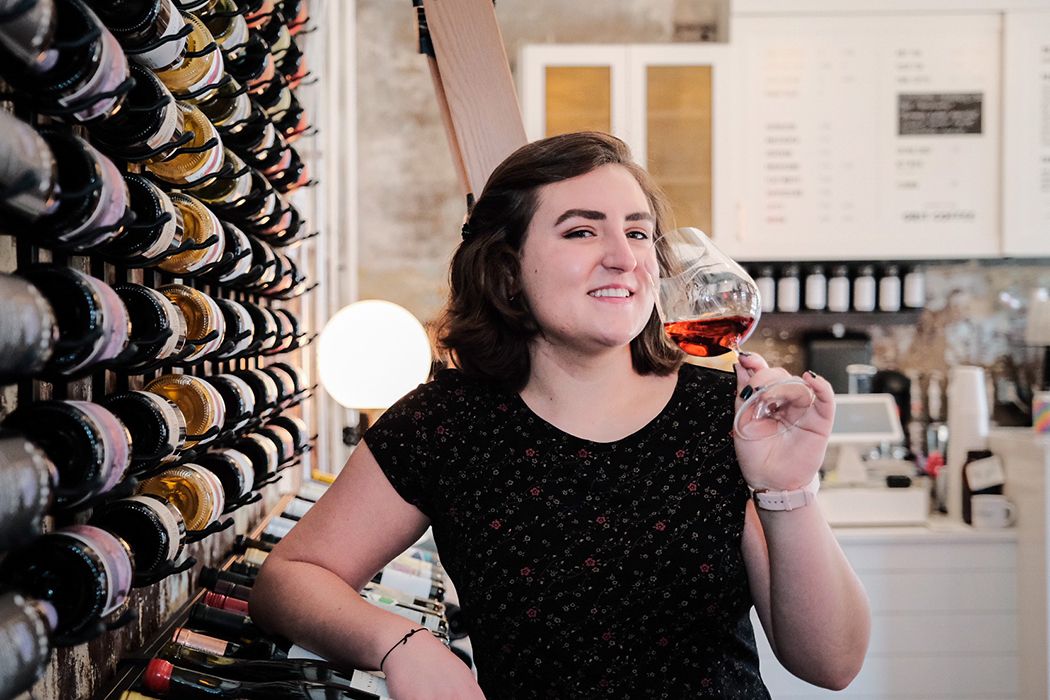Kylie Britt knows the wizardry behind winemaking. And she wants you to know it, too.
“I think it’s important to know where wine comes from and the people who make it, but I want to share that in accessible ways,” says the aspiring consultant and current “wine specialist” at The Wool Factory.
Britt’s journey into wine science began at the University of Richmond, where she studied chemistry—among a slew of other subjects. She liked chem enough to start a Ph.D. in it, but soon found she was looking for a more applied brand of science. A job at a retail wine shop in Durham, North Carolina, gave her direction. She found her next oeno-industry post at Michael Shaps Wineworks in Charlottesville.
Britt’s knowledge of wine and its production process grew, as did her own appreciation of the vine’s versatility, which led to her current Wool Factory job, where she organizes retail, does bottle service at Broadcloth, and helps educate staff.
Last year, Britt launched Teacher’s Pet Nat to provide outside customers wine education consulting. But COVID-era obstacles have held the business back, and for now, she’s using a Teacher’s Pet Nat-branded Instagram (@teachers_pet_nat) to push out pointers—slide shows on what makes wine sweet, different kinds of hybrid grapes, the spritzy piquette wine style, etc. She hopes to begin helping wine lovers with events and tastings, and restaurants with staff training as folks become more comfortable meeting in groups. “I’m still figuring out exactly where I want to be,” Britt says.
Britt’s dipped her feet in consulting through a few public education events—tastings outside of those she does weekly at The Wool Factory’s Workshop. She tries to build her educational events around themes: think sensory analysis or tasting through a scientific lens. And that’s something she’d like to continue as Teacher’s Pet Nat grows.
Since she’s moved to Virginia, Britt has become obsessed with the state’s booming winemaking practice. She comes to wine from a modern, rather than traditional, background—“I tasted meritage before a Bordeaux blend,” she says—and that helps her appreciate what she sees as the state’s strong suit: taking old-world techniques and turning them on their tête. “The culture of wine is there, and we’re figuring out how we fit into it,” she says.
Britt says some of the highlights of Virginia vino are producers’ willingness to experiment with new varietals, such as Austrian Blaufränkisch, and wine-cider hybrid styles, such as the co-fermented pét-nats at Patois Cider in Albemarle County.
So, what is all this about pét-nat anyway? The term is short for pétillant naturel, a process by which winemakers let their juice ferment at least partially in the bottle. The finished products are light, semi-sparkling wines that can be unpredictable and exciting in terms of sweetness and flavor profile.
“Pét-nat is a sparkling wine that undergoes one fermentation rather than two,” Britt says. “A lot of traditional sparklings use two—they’re still wines and you add carbonation. Pét-nat takes advantage of the carbon dioxide produced during initial fermentation. Every bottle is unique, and it’s a pure representation of the fruit and the earth.”
Natural wines in general are all the rage, Britt says, but pét-nat is distinct because consumers can be sure of the process being used. Folks making “natural” wine might eschew sulfites, or they might be low-intervention and/or organic-certified. Other producers making great wines that are indeed natural might not pay to be designated as such.
If it’s all a little confusing, that’s where Teacher’s Pet Nat comes in. “It’s for nerds and newbies,” Britt says. “It’s wine education for everyone.”
